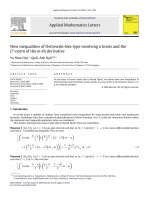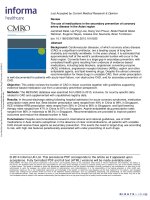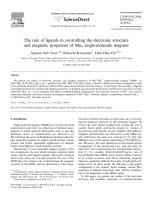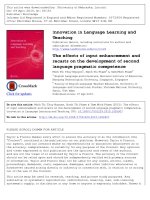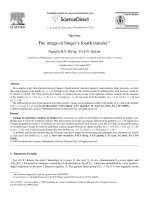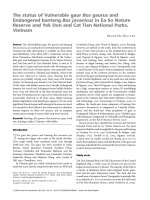DSpace at VNU: The measurements of uranium enrichment by using X rays and gamma rays below 100 keV
Bạn đang xem bản rút gọn của tài liệu. Xem và tải ngay bản đầy đủ của tài liệu tại đây (222.18 KB, 7 trang )
VNU Journal of Science, Mathematics - Physics 28 (2012) 77-83
The measurements of uranium enrichment by using X rays and
gamma rays below 100 keV
Bui Van Loat1*, Le Tuan Anh1, Nguyen Van Quan1
DinhVan Thin1, Nguyen Cong Tam2
1
Faculty of Physics, VNU University of Science, 334 Nguyen Trai, Hanoi, Vietnam
2
Institute of Isotopes of Hungarian Academyof Sciences, Budapest, Hungary
Received 17 March 2012, received in revised from 09 April 2012
Abstract. In this work the non-destructive gamma - spectroscopic method for determination of
uranium enrichment is presented. The method is applicable to material of any physical form and
geometrical shape, and does not require the use of reference materials or the use of efficiency
calibrated geometry. The X Rays and gamma rays below 100 keVfrom 235U were used to
determine their relative detection efficiency internally. The activity ratios of 234U/235U and
U238/U235in studied sample were calculated based on the measurents of the count rate of 53.2keV
(0.123%) gamma ray of 234U and 92.6 keV (5.16%) of 234Th, a daughter of 238U. As a test of this
method, a highly enriched uraniumsample was measured. The obtained result was in agreement
with the estimated value.
Keywords: Uranium enrichment, gamma-spectrometry, intrinsic efficiency calibration, MGA
method.
1. Introduction∗
Nowadays, uranium is most commonly used fuel for nuclear power plantsfor production of
electricity. The determination of the uranium enrichment is very important in various fields such as
nuclear power generation, nuclear safeguards, radiation protection and especially fight against illicit
international traffic of radioactive materials and nuclear terrorism. Gamma-ray spectrometry has found
increased application in resent years for determining uranium enrichment [1,2].
The object of uranium enrichment measurement is to determine the activity ratios of uranium
isotopes. Normally, the activity ratio of 238U/235U in the studied samples were calculated based on the
count rate of 185.72 keV gamma line of 235U; 111 keV- X rays (238U) and 1001 keV gamma line of
234m
Pa, a first daughter of 238U. Before the analysis, the efficiency calibration of the system was carried
out by using some standard sources [1,3]. The method doses not require the use of standard samples or
_______
∗
Tác giả liên hệ. ĐT: 84-912865869
E-mail:
77
78
B.V. Loat et al. / VNU Journal of Science, Mathematics-Physics 28 (2012) 77-83
the knowledge of the absolute detector efficiency, but uranium enrichment were measured using
gamma ray above 100 keV [4,5,6].
In this work,the uranium enrichment of investigated sample is derived from the activity ratios
U/235U, U238/235U using gamma rayswith energy below 100 keV. The activity of 234U is determined
from 53.200 keV (0.00123) photopeak area of 234U. The activity of 235U is determined from 58.57
keV(0.0048), 81.228 keV (0.0085), 82.087 keV (0.073), 84.214 keV (0.0671) peaks of 231Th, daughter
of 235U and 89.956 keV (0.041), 93.356 keV (0.055), 95.86 keV (0.0088) X-ray peaks of 235U- IC. The
activity of 238U can be determined based on the 92.365 keV (0.026) and 92.79 keV (0.0256) peaks of
234
Th, daughter of238U.
234
2. Method for determination of uranium enrichment
Uranium enrichment is determined based on the measuring the activity ratios AU234/AU235 and
AU238/ AU235. To determine the isotopic activity ratio, the multigroup gamma-rays method (MGA
method) was used [4]. The method is to measure basically the intensity of two or more peaks from
gamma-rays with similar energy but from different isotopes. Then the activity ratio of two different (1
and 2) isotopes can be expressed as follows:
A1 n1 .Br2 .Ω 2 .ε 2 .τ 2
=
A2
n 2 . Br1 .Ω 1 .ε 1 .τ 1
(1)
where A1,A2 are the activities of two isotopes 1 and 2 respectively; n1,n2 are the net count rates of
the photopeak corresponding to gamma rays γ1 and γ2 with a specific energy E1 and E2 from isotopic 1
and 2 respectively; Br1 and Br2 are branching ratios for γ1, γ2 rays; Ω1, Ω2 are the fractional solid
angle of detector. Here, they are the same of both γ1 and γ2 and can be ignored; ε1, ε2 are the efficiency
for the energies E1 and E2 of γ1 ray, γ2-ray from two isotopes respectively; τ1 and τ2 are gamma
transmission to detector of γ1 and γ2 respectively. If the two γ1-ray,γ2 ray are close to the same energy,
it gets τ1.ε1≅ τ2.ε2. Now Eq. (1) becomes:
A1 n1.Br2 n1 / Br1 n1 / Br1
=
=
=
A2 n2 .Br1 n2 / Br2 f ( E )
(2)
n ( E2i )
, with E2i is energy of γ i from isotope 2, is called intrinsic efficiency
Br ( E2i )
function, which depend on energy of gamma rays [5,6,7].
where f ( E ) =
The uranium enrichment of 235U, q235 (%) is calculated by using the following equation:
q235 =
m235
1
=
.100%
m235 + m234 + m238 1 + m234 / m235 + m238 / m235
(3)
where m234,m235 and m238 are the masses of 234U,235U and 238U respectively in investigated sample.
79
B.V. Loat et al. / VNU Journal of Science, Mathematics-Physics 28 (2012) 77-83
238
The enrichment of uranium isotopes can be expressed as a function of activity of
U as follows:
q235 =
To determine
Au238/ A235 .
235
234
U,
1
.100%
AU 234
AU 238
1 + 3.479.10 .
+ 6.43.
AU 235
AU 235
235
U and
(4)
−4
U isotope enrichment, we have to measure the activity ratios ofAu234/A235 and
3. Experimentaland results
3.1. Uranium sample measurements
The enriched uranium sample was in the form of oxide (U3O8), which is sent to Institute of
Isotopes of the Hungarian Academy of Sciences by the International Technical Working Group on
Combating Illicit Trafficking of Nuclear Materials (ITWG). All measurements were carried out at
Institute of Isotopes of the Hungarian Academy of Sciences.The data were analyzed at Nuclear
Department of Physics, University of Sciences, VNU. The U3O8 powder was placed within a thin,
closed polyethylene cylinder of 2.9cm inner diameter. The sample was measured at 10cm distance
from the detector. The gamma spectra were taken by using a planar HPGe detector model GLP10180/07 (ORTEC) with active diameter of 10mm and thickness of 7mm. The gamma spectra were
being recorded until the statistical error of the 53,2 keVand 92.6 keV gamma peaks dropped below
1.5%. The gamma spectra were measured and analyzed by using the Gamma-Vision and Genie2000
program. Typical gamma spectrum of high enriched uranium is shown in Fig.1. From Fig.1 we can see
that: Counts of the 53.2 keV and 58.57 keV gamma ray peaks of 234U are stongest ( table 1) and
isolated. The 81.228 keV (0.0085), 82.087 keV (0.073), 84.214 keV (0.0671) gamma peaks of 231Th
and 89.956 keV (0.041), 93.356 keV (0.055), 95.86 keV (0.0088) X ray peaks of 235U-IC have high
counts, but many of them are overlapped.
Fig.1. Gamma ray spectrum of 5 g enriched uranium sample with the measuring time 43.56 h
80
B.V. Loat et al. / VNU Journal of Science, Mathematics-Physics 28 (2012) 77-83
3.2. Analyze multipletphotopeak into components
To analyze multiplet photopeak into components, the least squares fitting method was used. In The
deconvolution treatment of x- ray and γ- ray peaks in the spectra are carried out by fitting with a
Gaussian function for γ- ray and pseudo Voigt function for x-rays [7,8,9,10]. The Voigt
FunctionVp(E), which is expressed by a weighted sum of Gaussian, G(E) and, Lorentzian, L(E)
functions, both added to linear background, B(E):
(5)
V p ( E ) = kG ( E ) + (1 − k ) L ( E ) + B ( E )
where G(E) and L(E) functions with the same full-width at half – maximum, Γ = F W H M and the
factor, k = 0.57 in a pseudo Voigt function are defined as function of the energy, E as:
2
E − Ej
G ( E ) = N max exp − ln 2
Γ / 2
L( E ) =
(6)
N max
1 + ( E − E j ) / (Γ / 2)
(7)
2
where Ej is peak energy and Nmax is peak counts, respectively.
A highly- enriched uranium γ - ray spectrum in the energy region of 80 keV -100 keV
taken by a planar HPGe detector and fitted with Gaussian function for γ- ray and pseudo Voigt
function for X-rays using Origin 7.5 (Fig 2). The net peak areas are determined (Table1). The
branching ratios for γ- rays in Table 1 were taken from reference [9,10].
6
95.86 keV
93.356 keV
92.29 keV
5
10
89.956, keV
84.214, U-235
98.443 keV
81.228 keV
82.087 keV
Counts/channel
10
4
10
1050
1100
1150
1200
1250
1300
1350
Channel number
Fig. 2. A highly- enriched uranium γ - ray spectrum taken by a planar HPGe detector and fitted with Gaussian
function for γ- ray and pseudo Voigt function for X-rays.
81
B.V. Loat et al. / VNU Journal of Science, Mathematics-Physics 28 (2012) 77-83
Table.1. Characteristic of rays-gamma and measured results in below 100keV region
Energy(keV)/
Branching ratio –Br
Photopeak area
(count)
Net count rates of the
photopeak
n(cps)
n/Br (cps)
53.2
0.00123
144860
0.924÷0.002
751.1
58.57
81.228
82.087
84.214
89.944
92.6
93.356
95.86
0.0050
0.0085
0.0038
0.0671
0.0094
0.0516
0.055
0.0088
23073
104857
47478
834449
551636
7893
847300
148320
0.147÷0.001
0.669÷0.002
0.303÷0.001
5.321÷0.006
3.518÷0.005
0.024÷0.004
5.403÷0.006
0.946÷0.002
29.42 ± 1.7
78.67 ± 2.78
78.45 ± 3.1
79.30 ± 1.2
85.80 ± 5.9
0.975 ± 0.048
98.49 ± 9.0
107.48 ± 5.3
± 11.3
Parent
234
U
235
U
U
235
U
235
U
235
U
238
U
235
U
235
U
235
3.3. Determination of the uranium enrichment of material
The 234U activity is determined directly from 53.2 keV gamma ray. By using relative efficiency
calibration and from the equation (2), the AU234/AU235ratio was derived as follows:
AU234/AU235 =
n ( 53.2 ) / Br (53.2)
.
f (53.2)
(8)
Determination of the 238U activity is based on92.6 keV gamma peak (92.365 keVpeak
(0.0260) and 92.79 keV (0.0256) of 234Th. According to Eq. (2), the AU238/AU235 was determined using
relative efficiency calibration, as follows:
AU238/AU235 = n ( 92.6 ) / Br (92.6)
(9)
f (92.6)
In this case, the function f(E) is obtained by fitting experimental data of relative efficiencies at the
58.57 keV,81.228 keV, 84.214 keV peaks of231Th and 89.956 keV, 93.356 keV, 95.86 keVX- peaks of
235
U- IC (Fig. 3).
120
Eperimental data
Fitted curve
cps/Br
100
80
60
40
20
0
50
55
60
65
70
75
80
85
90
95
100
Energy (keV)
Fig. 3.The relative efficiency curve using the gamma peaks of U235,
f(E) = 0.01774E2 +4.54148E -175.50361, with the value of R2 = 0.989
82
B.V. Loat et al. / VNU Journal of Science, Mathematics-Physics 28 (2012) 77-83
The activity ratios AU234/AU235and AU238/AU235were then calculated using the Eqs. (8) and (9)
respectively.The obtained values are as follows:
AU234/AU235 = 30.2 ± 2.1. (Bq/Bq)
AU238/AU235 = 0.0102 ± 0.0012 (Bq/Bq).
Uranium enrichment of the investigated sample, q235, was determined based on the activity
ratio AU234/AU235 and AU238/AU235 and using Eq. (4). Experimental result for the investigated uranium
sample is: q235 = (92.9 ± 5.1) %. According to IAEA uranium enrichment of the investigated sample is
90%.
4. Conclusion
From the results in this work, we can see that the gamma-spectrometric technique can be used to
determine precisely the uranium enrichment of highly enriched uranium samples.The uranium
enrichment of investigated sample was calculated from the activity ratio 234U/235Uand 238U/235U. The
activity 234U, 235U, U238 can be determinedby using X - rays and gamma rays below 100 keV. The X –
rays and γ- rays spectra were analyzed by fitting a Gaussian function for γ- ray and pseudo Voigt
function for X-rays respectively.The main sources of the errors are statistical error, net peak area
determination, gamma ray self absorption, fitting procedure and nuclear data used. The result obtained
is in good agreement with estimated value from IAEA.
Acknowledgments
This paper is completed with financial support from Project QG.TD. 12-02 of VNU.
References
[1] A Luca, Experimental Determination of the Uranium Enrichment Ratio, Rom.Journ.Phys,Vol 53, Nos. 1- 2,P35 39, Bucharest,2008.
[2] Y.Y. Ebaid, Use of gamma-ray spectrometry for uranium isotopic analysis in environmental samples, Rom.
Journ. Phys. Vol.55,Nos 1-2 P69-74, Bucharest,2010.
[3] H. Yucel, H.Dikmen, Uranium enrichment measurements using the intensity ratios of self- fluresence Xray92*keV gamma ray in UXKα spectral region, Talanta 78 (2009) pp 410-417.
[4] W.D. Ruhter et all, Uranium enrichment measurement without calibration using gamma ray above 100
KeV,
Sym.on International Safeguards; Verification and Nuclear Material Security Vienna,Austra; October
29November 1,2001,p1-4.
[5] L.T.Anh, N.C.Tam, B.V.Loat- Determination some parameter of uranium material by gamma spectrometry using
intrinsic eficiency calibration- Proceeding of the topical conference on nuclear physics, hihg energy physics and
astrophysics ( NPHEAP-2010) 283-288.
[6] C.T. Nguyen, J. Zsigrai, Gamma-spectrometric uranium age-dating using intrisic efficiency calibration,
Nucl.
Instr. And Meth. B 243 (2006) 187.
B.V. Loat et al. / VNU Journal of Science, Mathematics-Physics 28 (2012) 77-83
83
[7] M.H. Nassef, W.EI Monwafi, and M.S.EI Tahawy. Non desteuctive assay for 235U determination in reference
materials of uranium oxide. Journal of Nuclear and Radiation Physics. Vol 4, No2,2009,pp65-73.
[8] D.J. Karangelosanf et all, Determination of depleted uranium in environmental samples by gamma- spectroscopic
techniques. Jour. of EnvironnmentalRadioactivity 76 (2004) 294-310
[9] HalukYÜcel, The applicability of MGA method for depleted and natural uranium isotopic analysis in the
presence of actinides, Applied Radiation and Isotopies 65 (2007) 1269-1280.
[10] Delynn Clark, U235 A gamma ray analysis code for uranium isotopic determination, Lawrence Livermore
National Laboratory, 1996



